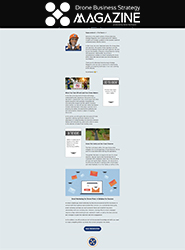
Welcome to this news update on unmanned aerial systems (UAS) in the United States. As commercial drone pilots it is essential that we fervently keep our fingers on the pulse of the UAS industry to help us plan, pivot, or proceed accordingly. In recent developments, US Senators Mark R. Warner (D-VA) and John Hoeven (R-ND) have proposed legislation to increase research and development in UAS technologies at the nation’s UAS test sites, and the authorization for the Federal Aviation Administration’s (FAA) UAS test sites has been extended until 2028.
This news highlights the growing interest in boosting uncrewed technology in the US and the importance of congressional action to ensure that UAS systems deliver benefits to society. Let’s dive deeper into the details.
Drones and Lawmakers
US Senators Mark R. Warner (D-VA) and John Hoeven (R-ND) have proposed legislation to increase research and development in unmanned aerial systems (UAS) technologies at the nation’s UAS test sites. These sites were established to verify the safety of public and civil UAS operations before their integration into the national airspace system. Currently, there are seven UAS test sites in the US, and the proposed bill extends the authorization for the Federal Aviation Administration’s (FAA) UAS test sites for an additional five years until 2028.
The Proposed UAS Bill
The bill formally authorizes research grants through the FAA to demonstrate or validate technology related to the integration of UAS in the national airspace system. A grant recipient must have a contract with an FAA UAS test site. The proposed bill also identifies key research priorities, including detect and avoid capabilities, beyond visual line of sight (BVLOS) operations, operation of multiple unmanned aircraft systems, unmanned systems traffic management, command and control, and UAS safety standards.
The proposed bill reflects a growing interest in boosting uncrewed technology in the US, such as the “Increasing Competitiveness for American Drones Act of 2023” introduced by Senators Warner and Thune in February. The bill aims to revamp the process for acquiring waivers from the FAA for drone flights beyond visual line of sight.
Federal Investment in UAS Research and Development
Lisa Ellman, Executive Director of the Commercial Drone Alliance (CDA), testified before the US House of Representatives Committee on Science, Space, and Technology last month on the need for increased investment in UAS technology. She explained how federal investment in UAS research and development could help the country maintain its leadership position in the field of advanced aviation and provide numerous benefits to society.
Dedicated UAS Test Sites
In the United States, there are currently seven test sites dedicated to unmanned aerial systems (UAS). These sites are:
- Griffiss International Airport
- New Mexico State University
- North Dakota Department of Commerce
- State of Nevada
- Texas A&M University Corpus Christi
- University of Alaska Fairbanks
- Virginia Polytechnic Institute & State University
The purpose of these sites is to ensure the safety of public and civil UAS operations before their integration into the national airspace system.
In introducing the new bill, Senator Warner said, “Unmanned Aerial Systems have the potential to transform the way we manage disasters, maintain our infrastructure, administer medicine, tackle national security threats, and conduct day-to-day business.” The proposed bill, along with recent legislative action and testimony, highlights the importance of congressional action to ensure that UAS systems deliver benefits to society. As Ellman told Congress in March, “Research and development has a critical role to play in enabling implementation of future UAS capabilities and in advancing AAM and drone security technologies.”
The Takeaway
The proposed legislation to increase research and development in unmanned aerial systems (UAS) technologies is a positive step towards boosting the use of drones in various industries in the US. The authorization of the Federal Aviation Administration’s (FAA) UAS test sites for an additional five years until 2028 and the identification of key research priorities will help ensure the safe integration of UAS into the national airspace system.
The growing interest and investment in UAS technology reflect the potential benefits it can bring to society, such as improving disaster management, infrastructure maintenance, national security, and day-to-day business operations.
Be smart, safe, and forever fly!
If you have any questions, let us know! If you’d like to hire us, you can get more information here.
Written by: Tony Marino, MBA – FAA Certified Part 107 Commercial Drone Pilot and Chief Business Strategist at Aerial Northwest
Frequently Asked Questions
References
Commercial UAV News. (2023, April 11). Warner, Hoeven Introduce Legislation to Reauthorize UAS Test Sites, Support Unmanned Aerial Systems Research & Development. https://www.commercialuavnews.com/regulations/warner-hoeven-introduce-legislation-to-reauthorize-uas-test-sites-support-unmanned-aerial-systems-research-development
Federal Aviation Administration. (n.d.). Unmanned Aircraft Systems (UAS) Test Sites. Retrieved April 10, 2023, from https://www.faa.gov/uas/programs_partnerships/test_sites/
Disclaimer: The information provided in this blog post is for general informational purposes only and should not be construed as legal advice.

DRONE BUSINESS STRATEGY MAGAZINE
A free digital publication made exclusively for all small business drone pilots to them help start-up, become profitable while sustaining a competitive advantage within the drone service industry sector they opt to serve.
“If you love to fly, we’d love to have you come aboard!”
We share your information with no one. Our Privacy Policy.










Leave a Reply
Your email is always safe with us.